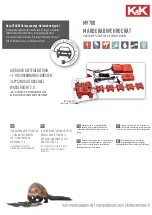
MODELS CBV-S/A
2
ITEM
1040 SERIES
DATED
JANUARY 2015
CALIFORNIA PROPOSITION 65 WARNING:
This product and related accessories
contain chemicals known to the State of California to cause
cancer, birth defects or other reproductive harm.
INSTALLATION:
To ensure accuracy of measurement, the CBV should be
located at least five pipe diameters downstream from any fitting
and at least ten pipe diameters downstream from a pump. Two
pipe diameters downstream from the CBV should be free of any
fitting (as illustrated in Fig. 1).
CBV valves must be installed with flow in the direction of the
arrow on the valve body. Easy access to the probe metering
ports (P.M.P’s) and handwheel must be provided.
CBV valves can be installed in horizontal or vertical piping.
The metering ports should never be installed below the
pipe (pointing down), as this will allow system sediment to
accumulate in the ports. (Illustrated below for horizontal piping
in Fig. 2.)
CBV angle-style valves are designed to replace piping elbows.
Metering ports and body plugs may be interchanged for
improved accessibility.
BOLT TIGHTENING:
Tighten all bolts evenly in standard star pattern. When used
with a “raised face” flange, there will be a gap between the
faces on the outer flange diameters.
CONVERSION (STRAIGHT TO ANGLE):
1. Open the valve one complete turn.
2. Remove the body bolts from the valve body.
3. Rotate one-half of the valve body 180˚, making sure the seat
and O-ring stay in position and do not get nicked or cut.
4. Replace the body bolts and tighten evenly.
5. With no arrows visible, the inner scale set at 0 on the
indicator line aligned with the 0 on the outer scale, the valve
is closed. Refer to Fig. 3.
6. Figure 4 shows a valve setting of 2.0, indicating that the
valve is partially open.
7. With all arrows visible, the inner scale set at 6 and the
indicator line aligned with outer scale 0, the valve setting is
6.0 and the valve is fully open. Refer to Fig. 5.
OPERATION:
The valve operates from closed (Fig. 3) to fully open by a
counterclockwise rotation of the red handwheel. Use five (5)
380˚ turns for the 2-1/2" and 3" valves, six (6) turns for the
4", 5", and 6" valves, 12 turns for the 8" and 10" valves and
14 turns for the 12" valve. Two scales indicate the position of
the valve.
Inner Scale (Figs. 4 and 5) – This sleeve has a vertical arrowed
scale which indicates the number of full turns the valve has
been opened.
Outer Scale (Figs. 4 and 5) – This scale is a micrometer-type
scale marked 0–9 at the tapered base of the handwheel. Each
gives 1/10th indications for each 360˚ turn of opening against
the indicator line of the inner scale. Connect meter quick-
disconnect hoses to metering ports as follows:
• Remove protective cap from metering ports.
• Insert and lock the meter probe into the metering ports.
Model CBV-A – Angle Design
Model CBV-S – Straight Design
Fig. 1
Fig. 3
Fig. 4
Fig. 5
Fig. 2
(1) Metering Port
(2) Body Port & Drain
(3) Handwheel






















